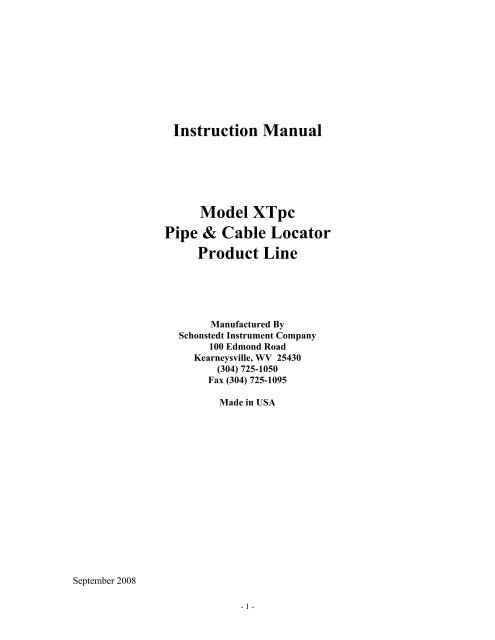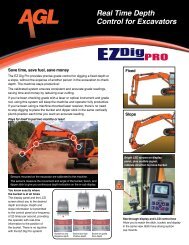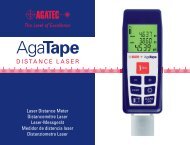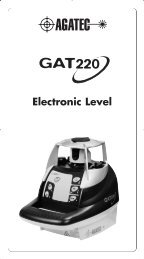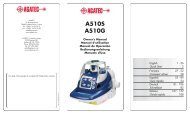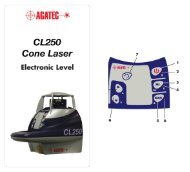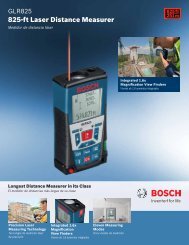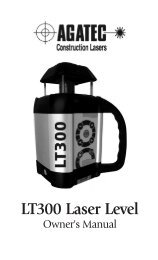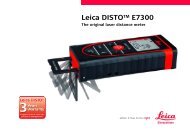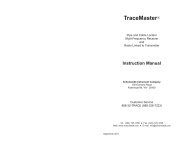Instruction Manual Model XTpc Pipe & Cable ... - EngineerSupply
Instruction Manual Model XTpc Pipe & Cable ... - EngineerSupply
Instruction Manual Model XTpc Pipe & Cable ... - EngineerSupply
Create successful ePaper yourself
Turn your PDF publications into a flip-book with our unique Google optimized e-Paper software.
<strong>Instruction</strong> <strong>Manual</strong><strong>Model</strong> <strong>XTpc</strong><strong>Pipe</strong> & <strong>Cable</strong> LocatorProduct LineManufactured BySchonstedt Instrument Company100 Edmond RoadKearneysville, WV 25430(304) 725-1050Fax (304) 725-1095Made in USASeptember 2008- 1 -
Table of ContentsSECTION I: OPERATING MODESPassive 50/60 Hz (P) .................................................................................................................. 4Passive Cathodic (PC)................................................................................................................ 4Conductive (C)........................................................................................................................... 4Inductive Clamp (IC) ................................................................................................................. 4Inductive (I)................................................................................................................................ 4Sonde (S).................................................................................................................................... 4SECTION II: THE <strong>XTpc</strong> PRODUCT LINEProducts Covered By This <strong>Manual</strong> ............................................................................................ 6<strong>Model</strong> Comparison Chart........................................................................................................... 6Automatic and <strong>Manual</strong> Gain ...................................................................................................... 7Directional Indication................................................................................................................. 7Depth Measurement ................................................................................................................... 7Automatic and <strong>Manual</strong> Output Power........................................................................................ 7Transmitter Current Measurement ............................................................................................. 7Transmitter Time Out................................................................................................................. 8SECTION III: OPERATING CONTROLSReceiver ..................................................................................................................................... 9Transmitter .................................................................................................................................10SECTION IV: VISUAL AND AUDIBLE INDICATORSReceiver .....................................................................................................................................11Transmitter .................................................................................................................................12SECTION V: CONNECTORS AND ACCESSORIESReceiver Connector....................................................................................................................14Transmitter Connector ...............................................................................................................14Standard Accessories .................................................................................................................14Optional Accessories..................................................................................................................14SECTION VI: BATTERIES AND CHARGERReceiver Battery.........................................................................................................................15Transmitter Battery ....................................................................................................................15Transmitter Battery Charger.......................................................................................................15Recommendations for Battery Charging and Storage ................................................................16SECTION VII: SPECIFICATIONSReceiver .....................................................................................................................................17Transmitter .................................................................................................................................17SECTION VIII: OPERATING RECOMMENDATIONS .......................................................................18SECTION IX: TROUBLESHOOTING GUIDE......................................................................................19SECTION X: TECHNICAL SUPPORT ..................................................................................................19SECTION XI: WARRANTY / SERVICE INFORMATION ..................................................................19- 2 -
Important NoticeSchonstedt believes the statements contained herein to be accurate and reliable. But their accuracy,reliability, or completeness is not guaranteed.Schonstedt's only obligation shall be to repair or replace any instrument proved to be defective within sevenyears of purchase. Schonstedt shall not be responsible for any injury to persons or property, direct orconsequential, arising from the use of any instrument.Important FCC NoticeThis unit has been tested and found to comply with the limits for a Class B digital device, pursuant to Part15 of the FCC Rules. These limits are designed to provide reasonable protection against harmfulinterference in a residential installation. This unit generates, uses and can radiate radio frequency energyand, if not installed and used in accordance with the instructions, may cause harmful interference to radiocommunications. However, there is no guarantee that interference will not occur in a particular installation.If this unit does cause harmful interference to radio or television reception the user is encouraged to to tryto correct the interference by reorienting or relocating the receiving antenna, or by increasing the separationbetween the equipment and the receiver.- 3 -
SECTION I: OPERATING MODES<strong>Pipe</strong> and cable locators in general can operate in a variety of modes and frequencies. The following is abrief description of the basic operating modes supported by the <strong>XTpc</strong> line of pipe and cable locatorsPassive 50/60 Hz (P)In the passive mode the transmitter is not used at all. Instead, the receiver searches for an appropriateharmonic of 60 or 50 Hz signals (factory preset). These signals are typically present in energized powercables, making it possible to locate them without the use of a transmitter to impose a tracing signal onthem.Passive Cathodic (PC)Long pipelines usually have to deal with the issue of corrosion. A known group of techniques used tocontrol corrosion involves the use of periodic cathodes along the pipeline and the circulation of low-levelcurrents rectified from the power grid. The passive cathodic mode does not use the transmitter at all.Instead, the receiver searches for an appropriate harmonic of rectified 60 or 50 Hz from the power grid,therefore making it possible to trace pipelines for long distances without the use of a transmitter to imposea tracing signal on them.Conductive (C)In the conductive mode the transmitter imposes a signal of the "active" frequency onto the pipe or cable tobe traced. It does so by making direct contact with the pipe or cable at a point where it comes up to thesurface (a transformer box, a water hydrant, a telephone switch box, a gas meter, etc.). The circuit is closed,providing a return path, by a ground stake that is buried in the ground in the vicinity of the transmitter.Inductive Clamp (IC)In the inductive clamp mode the transmitter imposes a signal of the "active" frequency onto the pipe orcable to be traced. It does so by energizing a "clamp" that is placed completely encircling the pipe or cableat a point where it comes up to the surface (a transformer box, a telephone switch box, a gas meter, etc.).The clamp then induces a current on the pipe or cable. In this mode it is not necessary to provide a returnpath for the induced current to the transmitter. The induced current will travel on the pipe or cable for adistance making it possible to trace it.Inductive (I)In the inductive mode the transmitter imposes a signal of the "active" frequency onto the pipe or cable to betraced. It does so by radiating a signal through the inductive antenna, which is placed on the ground in adirection perpendicular to the pipe or cable being traced. The inductive antenna then induces a current onthe pipe or cable. In this mode it is not necessary to provide a return path for the induced current to thetransmitter. The induced current will travel on the pipe or cable for a distance making it possible to trace it.Sonde (S)In the sonde mode the transmitter is not used at all. This mode is used to trace non-metallic pipes, ormetallic pipes where the other modes are inapplicable or inefficient. A small sonde or "beacon transmitter"is pushed through the pipe by some means. The receiver searches for the signal emitted by the sonde. Since- 4 -
the signal being traced by the receiver is produced by the sonde, and not travelling along the pipes, thereare some differences in the way the receiver is used. Due to the nature and strength of the sonde signal, itis necessary to have some idea of where the sonde is, to narrow the search area to a circle of several feetradius centered at the sonde. This is usually not much of a problem, since the sonde is "guided" by a deviceunder control of the work crew, often with a camera attached to it.- 5 -
Automatic and <strong>Manual</strong> Gain<strong>XTpc</strong> receivers have the ability to operate in automatic gain mode or in manual gain mode. In automaticgain mode the sensitivity of the receiver is adjusted automatically, based on the strength of the detectedsignal, to produce a relatively constant and strong signal strength indication. In the manual gain mode theuser has the ability to adjust the sensitivity up or down to suit different locating scenarios.Directional Indication<strong>XTpc</strong> receivers are equipped with directional indicators. These visual and audible indicators help the userlocate the pipe or cable by showing in what direction he/she should move to get closer to the target. Theseindicators are not available in Sonde mode.Depth Measurement<strong>XTpc</strong> receivers have the ability to measure the approximate depth of the target pipe or cable being traced.The bottom tip of the receiver must touch the ground when depth measurement is made, and best results areobtained when the receiver is in a fully extended position. Depth measurements should only be made whenthe directional indication says that the target is directly below the receiver and the signal strength isadequate. Special considerations are required for the Sonde mode (see SECTION VIII: OPERATINGRECOMMENDATIONS for details).Automatic and <strong>Manual</strong> Output Power<strong>XTpc</strong> transmitters deliver power to the "load" connected to them. In the conductive mode the load is thecircuit formed by the cable or pipe being traced, the soil return and the ground stake. In the inductiveclamp and inductive modes the loads are the clamp and the antenna, respectively. The inductive clamp andinductive modes require the maximum power that the transmitter can deliver. Therefore the transmitterautomatically operates at maximum power output and there is no need for manual power adjustment.In the conductive mode the power delivered to the load is highly dependent on the external elements (soil,type of conductor, stake placements, etc.). The transmitter defaults to an automatic output power mode andtries to maintain a medium output current through varying conditions. But in some cases more power isdesired to achieve more distance or depth, in others less power is desired to avoid bleeding to nearbyconductors. Therefore in this mode the user has the ability to adjust the output power manually.Transmitter Current Measurement<strong>XTpc</strong> transmitters operating in the conductive mode measure and display the amount of current flowing outof the transmitter and into the utility being traced. This is very useful in determining how good a circuithas been established by the operator, and whether or not some improvements can be made by relocating theground stake or improving metal to metal contact of the conductive clips. A low current reading canindicate a poor trace conductor, poor soil conductivity or poor ground stake contact or placement. Highercurrent readings indicate a better circuit and therefore a better chance to trace longer distances and deeperconductors.If the current reading is low, you should try to improve the connection (check the cables, the clips, theground stake, wet the ground, clean rust or dirt, etc.) to see if the current increases. However, in manycases the reason for the low current is the soil itself (sandy or very dry) and/or the composition of the pipeor cable you are trying to trace (cast iron pipes, rusted or broken wires, heavy insulation to ground, etc.). Inthat case you may not be able to improve the connection. This does not mean that you won't be able to- 7 -
locate, it just means that there is a smaller amount of current circulating in the circuit. You may try toincrease the output power manually and/or increase your receiver gain.Transmitter Time OutThe <strong>XTpc</strong> transmitter will turn itself off after idling with no accessories plugged into the transmitterconnector after approximately 15 minutes. With an accessory plugged in, the transmitter will turn itself offapproximately 2 hours after the last key was pressed.- 8 -
SECTION III: OPERATING CONTROLSThe product controls are designed to be intuitive and require a minimum of training for effective use. Thereceiver can easily be operated with one hand. To operate the transmitter in the automatic poweradjustment mode the user needs only to connect the conductive clips, optional inductive clamp, or optionalinductive antenna and then turn the unit ON. The transmitter will then automatically recognize whichaccessory is plugged in and adjust its operating mode and settings accordingly.ReceiverON/VOLUME - This switch powers up the receiver and automatically sets the volume toHigh. Additional depressions of this switch will cycle the volume through Off (no sound),Medium, and High settings.OFF - This switch removes power from the receiver.UP/DOWN Arrows - When the receiver is operating in manual gain mode, pressing the UPor DOWN arrows will increase or decrease the gain from its current setting. When thereceiver is operating in the automatic gain mode, the first press of the UP or DOWN arrowwill switch the receiver to the manual gain mode.AUTO - When the receiver is operating in the manual gain mode, pressing the AUTO buttonwill switch the receiver to operate in the Automatic gain mode. In this mode the receiveradjusts its sensitivity as a function of the strength of the detected signal.DEPTH - When the proper conditions to measure depth are present, pressing this switch willdisplay the target's depth on the LCD, after a delay of 2.0 seconds. The depth will continueto be displayed on the LCD, along with the word "DEPTH", for as long as the switch isdepressed. If the switch is pressed and quickly released, the depth will show on the LCDmomentarily. The <strong>XTpc</strong> can be factory set to display depth in feet and inches or in meters. Ifthe depth cannot be determined due to a weak or noisy signal the LCD will show 3 dashes"---".SONDE - If the sonde mode is available and the receiver is not operating in sonde mode,pressing this switch will cause the receiver to go to the sonde mode of operation. If thereceiver is already operating in sonde mode, pressing this switch will cause the receiver tostop the sonde mode of operation.PASSIVE - If the receiver is not operating in passive mode, pressing this switch will causethe receiver to go to the passive mode of operation. If the receiver is already operating inpassive mode, pressing this switch will cause the receiver to stop the passive mode ofoperation.PC - If the passive cathodic mode is available and the receiver is not operating in passivecathodic mode, pressing this switch will cause the receiver to go to the passive cathodicmode of operation. If the receiver is already operating in passive cathodic mode, pressingthis switch will cause the receiver to stop the passive cathodic mode of operation.- 9 -
TransmitterON/OFF - This is a momentary push-button switch that toggles the power to the transmitteron and off. When the transmitter power is off, press this switch until the LCD indicatorscome on then release it, to turn the transmitter on. When the transmitter power is on, pressthe switch until the LCD indicators go off then release it, to turn the transmitter off.UP/DOWN Arrows - In the conductive mode the output power can be adjusted manually up ordown using these controls. After the first press of an arrow, the power adjustment mode switches tomanual and it can be adjusted to go above or below the setting of the Auto mode. To return thetransmitter to auto power, turn it OFF and then ON again.- 10 -
SECTION IV: VISUAL AND AUDIBLE INDICATORSThe information display areas for the receiver and the transmitter are large and easy to understand. Inaddition, the receiver has audible indicators as well, to facilitate operation in heavy traffic areas.ReceiverAll visual indicators for the receiver are on the LCD display, which has six general areas to displayinformation to the user: a Battery Indicator, a Gain Indicator, a Frequency/Mode Indicator, a DirectionIndicator, a Numeric Display and a Volume Indicator.BATTERY INDICATOR - The "Battery" symbol indicates the receiver's battery status. When all 3segments inside the battery symbol are present, the battery is fully charged. When only the 2 bottomsegments are present, the battery has a medium charge. When only the bottom segment is present,the battery has a low charge and should be replaced. If there are no segments present, the battery isextremely low and you should replace it immediately.GAIN INDICATOR - The "(Auto)" legend next to the "GAIN" legend indicates that the gain is in theautomatic mode. In this mode the receiver adjusts its sensitivity as a function of the strength of thedetected signal. No bar graph is shown in this mode.If the "(Auto)" legend is not visible the receiver is operating in the manual gain mode, and therefore ameans to show the user the gain setting is necessary. The bar graph indicates the relative strength ofthe gain, with each bar roughly representing one tenth of the full scale available. It takesapproximately 2 presses of the UP arrow to add one bar to the graph, and approximately 2 presses ofthe DOWN arrow to delete one bar from the graph.FREQUENCY/MODE INDICATOR - This LCD area consists of 4 icons:"SONDE", "33 kHz", "82 kHz", and the "Passive Arrow". These icons are used bythemselves or in various combinations to indicate different operating modes, asshown in the following table.SONDE 33 kHz 82 kHz PASSIVE ARROWC, IC, I at 33 kHz Off On Off OffC, IC, I at 82 kHz Off Off On OffSonde at 33 kHz On On Off OffSonde at 82 kHz On Off On OffPassive 50/60 Off Off Off OnPassive Cathodic (*) On Off On OffSonde at 512 Hz On Off Off Off(*) <strong>Model</strong>s with Passive Cathodic support do not support sondesNote: C = conductive mode, IC = inductive clamp mode, I = inductive mode, See SECTION I:OPERATING MODES, for a description of these modes.DIRECTION INDICATOR - The arrows and center bar in this indicator tell the operator in which directionto move the receiver in order to be directly over the target (see also "Alternate Directional Indication"Section). The direction indicator does NOT work in the Sonde operating mode.Right Arrow - Receiver should be moved to the right to get closer to the target.Left Arrow - Receiver should be moved to the left to get closer to the target.Both Arrows and Bar - Receiver is placed directly over the target. This is also accompaniedby a beeping sound.- 11 -
When all three elements of this indicator are OFF, the signal strength is not adequate to make a directionaldetermination or you are not close to the pipe or cable being traced. Keep searching based on the signalstrength indication (see below) and the audio feedback, until one of the arrows comes ONALTERNATIVE DIRECTION INDICATOR (ADI) - The <strong>XTpc</strong> receiver is capable of presentingdirectional information to the user in a different way than the one described above. This alternate methodcan be accessed at any time by simultaneously pressing the ON button and the UP arrow button. WhenADI is active the sound emitted by the speaker is continuous when the Right Arrow is on, and interruptedor "beeping" when the Left Arrow is on. When both arrows and the center bar are on, the speaker issilenced. The speaker is also silenced when the signal strength is too weak to make an accurate directionalindication.The advantage of this mode is that the user can use the sound to know in what direction the instrumentshould be moved without looking at the display. A continuous tone means: "move to the right", a beepingtone means: "move to the left", and silence means: "you are right on the utility" (unless the signal is tooweak to make a determination).The <strong>XTpc</strong> can be returned to the normal directional indication mode by simultaneously pressing the ONbutton and the Down arrow button.NUMERIC DISPLAY - The numeric display is used to display signal strength and depth.Signal Strength - This is an indication of the relative signal level detected by the receiver and is afunction of the gain setting. Good signal strength will typically be between 200 and 800. The displayrange for signal strength is 0 to 999.Depth Reading - When measuring depth the word DEPTH lights up above the numeric display and thedepth of the target in feet and inches (or meters) is displayed as shown below:12 4 Ft - in (factory set) or 4.10 mThe display range for depth in ft and inches is 0" to 19 ft 11", and in meters is 0.00 m to 5.99 m.See also SECTION III: OPERATING CONTROLS/Receiver/DEPTH.VOLUME INDICATOR - The volume indicator consists of a speaker symbol with 3 sound wave bars. Ifthe volume is off, the speaker symbol with NO bars is shown, for medium volume the speaker symbol with2 bars is shown and for maximum volume the speaker symbol with 3 bars is shown.The speaker produces an audible indication of signal strength. The pitch of the sound will increase withincreasing signal strength. However, the volume is determined only by the VOLUME control, as explainedabove.Volume OFF Medium Volume High VolumeTransmitterAll visual indicators for the transmitter are on the LCD display, which has four general areas to displayinformation to the user: a Battery Indicator, a Power Indicator, a Numeric Display, and a Mode Indicator.There are no audible indicators for the transmitter.- 12 -
BATTERY INDICATOR - The "Battery" symbol indicates the transmitter's battery status. When all 3segments inside the battery symbol are present, the battery is fully charged. When only the 2 bottomsegments are present, the battery has a medium charge. When only the bottom segment is present, thebattery has a low charge and should be recharged as soon as possible. If there are no segmentspresent, the battery is extremely low and it should be recharged immediately. In addition, the batteryindicator is used to show that the charger is plugged in correctly. The battery box will be on, with all 3segments rolling. See SECTION VI: BATTERIES AND CHARGER for additional information on thebattery charging visual indicators.POWER INDICATOR - The power indicator consists of a 10-bar graph located to the right of theword "POWER" on the faceplate, plus the legend (Auto) at the bottom and to the right of the bargraph. Its objective is to provide an indication of what type of power adjustment mode the transmitteris operating at and, if operating in manual adjustment mode, provide a relative indication of the outputpower being delivered to the circuit.NUMERIC DISPLAY - The numeric display consists of 3 digits and it is used to display the measuredoutput current delivered to the circuit, as well as mode indications in the other operating modes. The outputcurrent is displayed in mA (milliamperes) and it can range from 0 to 180 mA (internally limited for safetyand battery life considerations).MODE INDICATOR - The transmitter operates only at its factory set active frequency (see <strong>Model</strong>Comparison Chart). When the transmitter is on and operational, the operating frequency will be displayedat the top left corner of the LCD.The transmitter automatically detects the operating mode when an accessory is plugged in (conductiveclips, inductive clamp, inductive antenna, or battery charger). Once detected, the mode is indicated to theuser by a combination of display indicators and legends, as shown in the following table:Accessory Operating ModeMode IndicatorPlugged InNone Not operational - Idle Numeric Display Legend says "On"Battery Symbol = LitFrequency Indicator = LitArrow indicators pointing to mode printed on the faceplate,along the right side edge of LCD, are all flashingBatteryChargerNot operational - Charging Numeric Display Legend says "CHA"Battery Symbol = Rolling bars inside battery boxFrequency Indicator = LitConductiveClipsInductiveClampInductiveAntennaConductiveClampInductiveArrow indicators = All OFFNumeric Display Legend = Shows output current in mABattery Symbol = LitFrequency Indicator = LitArrow indicator = Pointing to CONDUCTIVENumeric Display Legend says "CLP"Battery Symbol = LitFrequency Indicator = LitArrow indicator = Pointing to CLAMPNumeric Display Legend says "Ind"Battery Symbol = LitFrequency Indicator = LitArrow indicator = Pointing to INDUCTIVE- 13 -
Receiver ConnectorSECTION V: CONNECTORS AND ACCESSORIESThis 2.5mm phone plug accepts any mono or stereo earphones or headphones. The receiver automaticallydetects the insertion of the plug and routes the audio signals to the earphones or headphones, silencing theinternal speaker.Transmitter ConnectorThis circular, lock-type, 8-pin connector is used to connect the conductive clips, the optional inductiveclamp, optional inductive antenna, or the battery charger to the transmitter. The transmitter automaticallydetects what accessory has been plugged in and adjusts its operation and indicators accordingly. It isrecommended that you turn the transmitter's power OFF before removing or inserting accessories from/intothe connector.Standard AccessoriesA - Inductive Signal OutB - N/CC - Signal GNDD - Conductive / Clamp Signal OutE - Battery Charger +VF - Battery Temperature SensorG - Battery Charger GNDH - Accessory ID ResistorThe following accessories are included with all <strong>XTpc</strong> models: Hard carrying case <strong>Instruction</strong> manual Belt receiver holder cup Locating 101 Book Ground stake Locating DVD Conductive clips Universal power supply for battery charger w/ Disposable Battery for Receivercountry-specific power cord Battery charger for Transmitter Battery Vehicle power supply for battery chargerFor the XT512 model, the following accessories are included: Soft carrying bag <strong>Instruction</strong> manual Belt receiver holder cup Locating 101 Book Disposable Battery Locating DVDOptional AccessoriesMany optional accessories are available for the <strong>XTpc</strong> <strong>Pipe</strong> and <strong>Cable</strong> locator line. The following listincludes the most common ones, please contact Schonstedt for details and additional optional accessoriesnot listed below. Inductive antenna (33 kHz or 82 kHz) Inductive clamp (3-1/8" ID, 5" ID and 7" ID) Sondes (33 kHz, 82 kHz and 512 Hz) "Carry All " duffel bag Padded transmitter and accessory belt-pouch w/belt Shoulder strap Medium size conductive clips Large size conductive clips- 14 -
SECTION VI: BATTERIES AND CHARGERReceiver BatteryThe <strong>XTpc</strong> receiver is powered by one 9-volt disposable battery. The battery is located in the handle of theinstrument and can be accessed by turning the screw counterclockwise by hand or with the use of ascrewdriver or coin. To remove the battery, simply tilt the unit so that the handle is pointing down, and thebattery will slide out. When replacing the battery, look at the inside of the battery door for the properbattery orientation. (The positive terminal should be on the right on the inside of the unit) As a safetymeasure the unit has been "keyed" so that the battery will only make contact when it is inserted in thecorrect orientation. For this reason you should never have to force the battery door closed. If the batterydoes not seem to be going in all the way, remove the battery, reverse its orientation and then replace it.Transmitter BatteryThe batteries for the transmitter are 6 rechargeable NiMH cells packed to provide 7.2- volt, and need not bereplaced. It is recommended to first charge the batteries for at least 4 hours before the initial use. If yoususpect that the batteries are malfunctioning please contact Schonstedt Instrument Company.Transmitter Battery ChargerThe battery charger is especially designed to charge the internal NiMH, 7.2-volt battery pack that powersthe transmitter. It will typically charge a fully discharged battery in under 4 hrs and it has smart safetyfeatures to monitor the charge process.The color LED indicators work as follows:TRANSMITTERBATTERY STATUSREADY LIGHT(Green)CHARGING LIGHT(Yellow)Fully Charged ON OFFCharging OFF ON or FlashingThe charger can be powered by the included AC power supply or the included vehicle power supply. TheAC power supply operates from a range of input voltages and frequencies to suit most countries. Thevehicle power supply allows the battery to be recharged while driving from job to job. Its input voltage is12 to 14.4 VDC from a car battery.- 15 -
Recommendations for Battery Charging and StorageBefore normal charging can begin, the battery pack temperature and voltage must fall within predeterminedacceptable limits. The voltage must be above 6 V and the temperature must be between 50° and 104°F (10°and 40°C). When the charger detects that these two conditions are not met, it will continue to do just a"trickle charge" until the two conditions are met. Then it will start normal charging.If the battery is faulty, and it never reaches acceptable voltage to start normal charging, the chargercontinues to trickle charge until the safety timer runs out (~ 6 hrs), then it stops.If the battery is good, but the temperature never reaches acceptable range to start normal charging, thecharger continues to trickle charge. In this case only a small fraction of full charge will be reached after thenormal 4 hours of charging time.The higher the storage temperature, the faster the battery will self-discharge, reducing its shelf life. Therecommended storage temperature is 50° to 70°F (10° to 20°C). Storing the battery at higher temperaturecan reduce its overall life, storing at colder temperatures is preferred and beneficial.Due to battery composition and safety features built into the charger, it maybe necessary to do two or morefull-charging cycles to bring the battery back up to full capacity if it has been completely discharged. Ifyou suspect the battery has been fully depleted, such as when it has been in storage for a long time, or whenthe transmitter won’t even turn on, it is recommended to do at least two consecutive charging cycles beforeresuming normal use of the battery. Make sure you unplug the charger from the battery in between the twocycles.If the charger is charging the battery in normal charge mode, and the temperature rises above 140°F (60°C)before the battery is fully charged, then the charger will switch to trickle charge mode. In this case fullcharge may not be achieved after the normal 4 hours of charging time.- 16 -
SECTION II : SPECIFICATIONS(Specifications are subject to change without notice)ReceiverOperating Frequency:Battery:Battery Life:Audio Output:Weight (incl. batteries):Operating Temp.:Active and passive frequencies depending on model(see <strong>Model</strong> Comparison Chart)9 V Alkaline single battery12 hrs intermittent use10 - 1500 Hz determined by signal strength0 - 70 db SPL (Sound Pressure Level), volume controlledUnder 2.8 Lbs-4°F to 140°F (-20°C to 70°C)Overall Dimensions:Closed:Extended:17.5 in x 3 in x 8.5 in (44 cm x 7.6 cm x 21.5 cm)27.7 in x 3 in x 8.5 in (70 cm x 7.6 cm x 21.5 cm)Max. Depth Capability: Approximately 19' (5.8 m)Sonde mode approximately 5'- 8' (1.5m - 2.5m)TransmitterOperating FrequencyOutput Power:Dimensions:33 kHz or 82 kHz, depending on model(see <strong>Model</strong> Comparison Chart)33 kHz - 1.8 W maximum (conductive mode)82 kHz - 1.0 W maximum (conductive mode)7.2 in x 2.2 in x 1.5 in(18.3 cm x 5.6 cm x 3.8 cm)Battery Type: Rechargeable NiMH pack (7.2 V)Battery Life:Charging:Outputs/Inputs:Weight:Operating Temp.:8 hours intermittent operationSmart charger powered by AC supply or vehicle supplyCircular "smart" connector to:1) Inductive antenna2) Inductive clamp3) Conductive clips4) Battery chargerUnder 1.5 lbs-4°F to 140°F (-20°C to 70°C)- 17 -
SECTION VIII : OPERATING RECOMMENDATIONSFollow these tips and recommendations to operate your <strong>XTpc</strong> <strong>Pipe</strong> and <strong>Cable</strong> Locator:1) Whenever possible, use the conductive mode, which provides the strongest and best-coupled signal.2) When operating in conductive mode: The ground stake should be buried on a line perpendicular to the utility to be traced and as farfrom it as possible. Verify that a good circuit has been established by checking the output current from the transmitter. If necessary, make adjustments to the ground stake or clips to improve the connection. You can also manually adjust the output power to affect the output current.3) If using the inductive mode, place the antenna tube (attached to the transmitter) over the buried cableor pipe in the direction indicated by the arrows on the antenna tube label.4) If using the inductive clamp mode, place the clamp so that it completely encircles the desired cable orpipe. Make sure the clamp can fully close so that both ends touch.5) When operating in the passive mode, or the passive cathodic mode. Be aware of your surroundings andpossible interference from overhead power lines or nearby transformers or substations.6) In all operating modes, always set the gain at the minimum setting that shows a clear "peak" over thetarget. Optimum results will most likely be obtained with a signal strength reading between 200 and800. A reading of 999 indicates the signal is saturating the amplifiers and the gain should be reduced.7) Searching for a sonde:Once in the surroundings of the sonde, it is important to differentiate whether you are positioned alongthe axis of the sonde (the direction of the pipe) or off to either side. In the sonde mode the arrows arenot functional, so the signal strength is the only indication available, and it will be "null" (very close tozero) if the receiver is placed on the axis of the sonde with the plane of the sensors perpendicular to it.Move away from the axis and follow the direction that results in increasing signal strength. Rotate thereceiver back and forth and move in the direction that produces the maximum. As the receiver getscloser to the sonde the signal strength increases to a maximum when directly over the sonde, if theplane of the sensors is parallel to the axis of the sonde (approaching from a direction that isperpendicular to the direction of the pipe). A rotation of 90 degrees from this position should producea null. To measure depth simply place the tip of the unit on the ground and press the DEPTH buttonwhen the signal strength is at a maximum. The achievable depth depends on a number of factors, buttypically it is possible to read depth up to 5 to 8 feet.- 18 -
SECTION IX: TROUBLESHOOTING GUIDESymptom Possible Cause ActionReceiver Inoperative Discharged or faulty battery Replace batteryIncorrect battery polarity Check bottom of battery door for correctpolarity, and re-insert battery.No Audio Audio turned off Press the “ON” button on the receiver tocycle through the audio volume options.Transmitter Inoperative Discharged battery Charge battery as described in manual.Transmitter battery life is Battery not fully chargedshortCharge battery until the green light on thecharger comes on. Then unplug the charger,reconnect, and repeat charging cycle.SECTION X: TECHNICAL SUPPORTSchonstedt offers technical support and sales support. For any reason regarding usage and applicationplease contact our technical support team at 888-32-TRACE (888-328-7223).FOR SERVICE OR REPAIRPlease ship locator to:Schonstedt Instrument Company100 Edmond RoadKearneysville, WV 25430Attn: Customer Service Dept.SECTION XI: WARRANTY INFORMATIONThe Schonstedt Instrument Company (Schonstedt) warrants each product of its manufacture to be free fromdefects in material and workmanship subject to the following terms and conditions. The warranty iseffective for 3 years (with the return of the Customer Registration Card) after the shipment by Schonstedtto the original purchaser.Schonstedt's obligation under the warranty is limited to servicing or adjusting any product returned to thefactory for this purpose and to replacing any defective part thereof. Such product must be returned by theoriginal purchaser, transportation charges prepaid, with proof in writing, to our satisfaction, of the defect.If the fault has been caused by misuse or abnormal conditions of operation, repairs will be billed at cost.Prior to repair, in this instance, a cost estimate will be submitted. Service or shipping information will befurnished upon notification of the difficulty encountered. <strong>Model</strong> and serial numbers must be supplied byuser. Batteries are specifically excluded under the warranty.Schonstedt shall not be liable for any injury to persons or property or for any other special or consequentialdamages sustained or expenses incurred by reason of the use of any Schonstedt product.- 19 -


